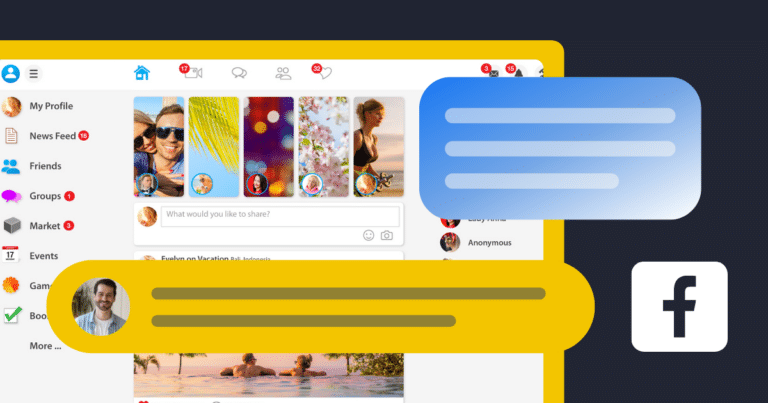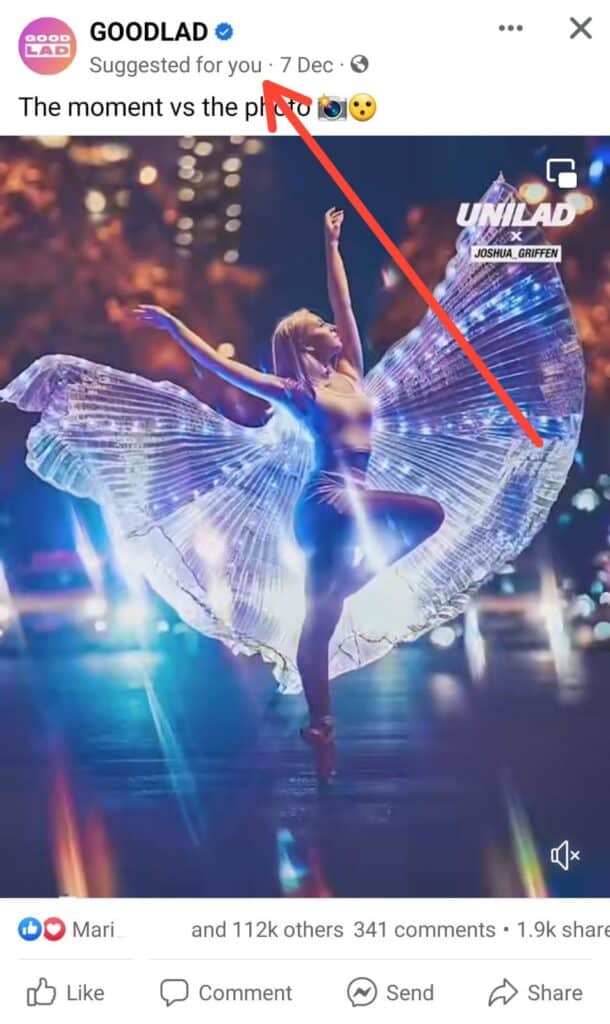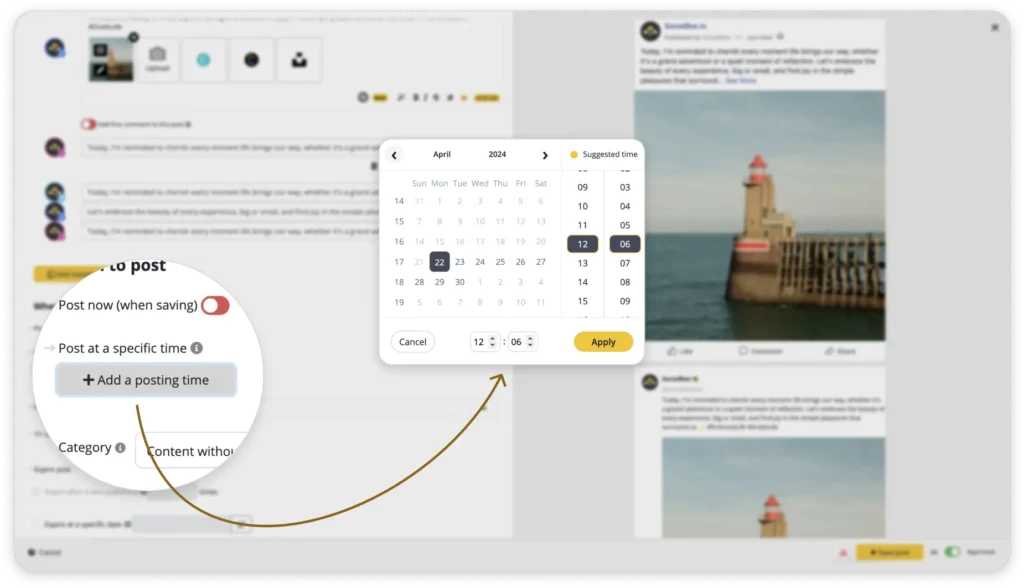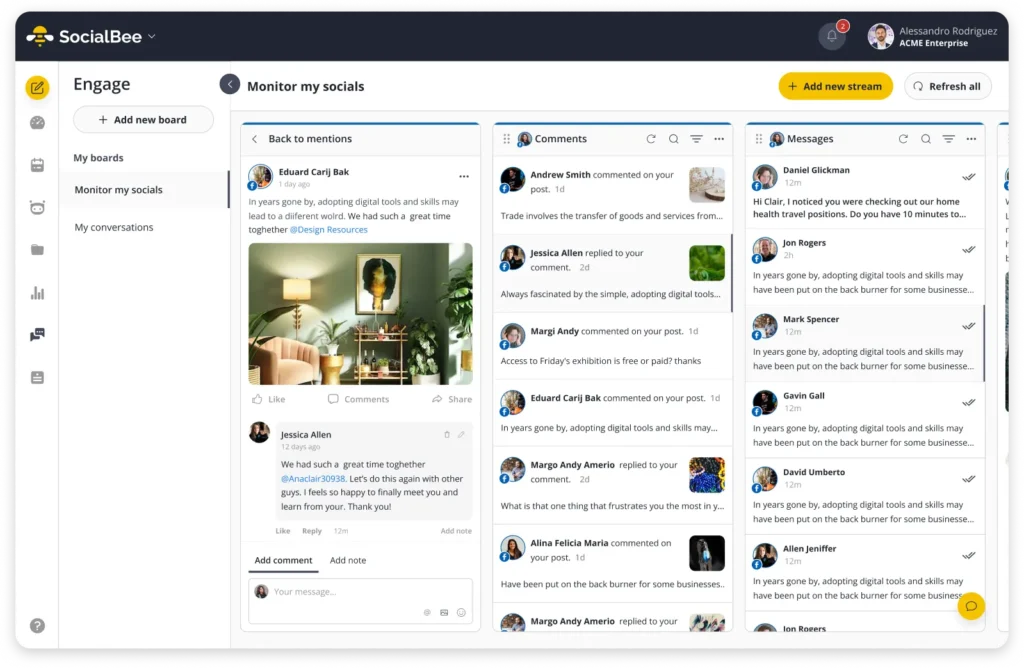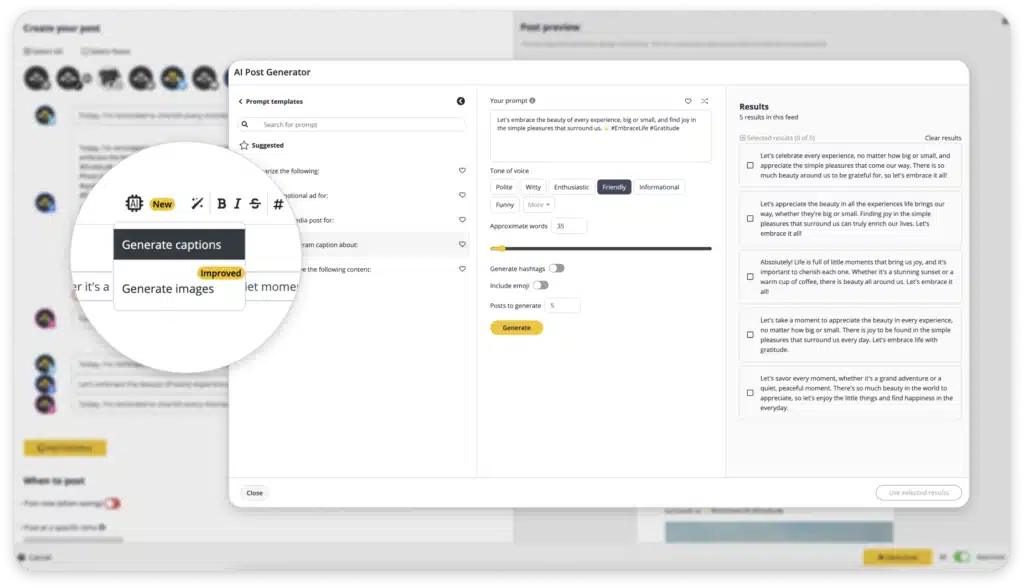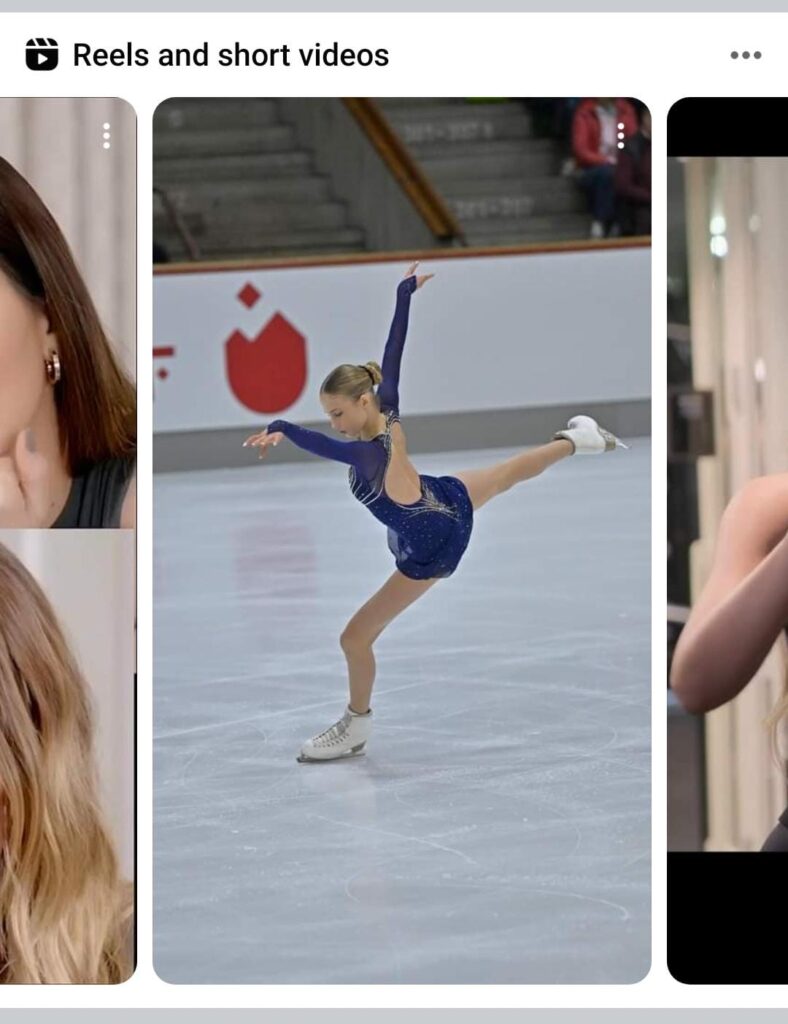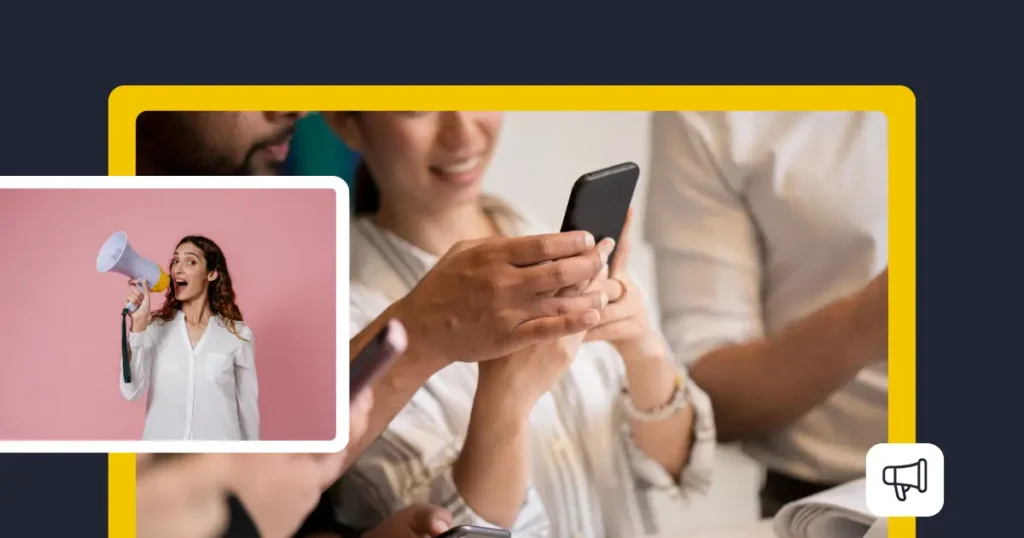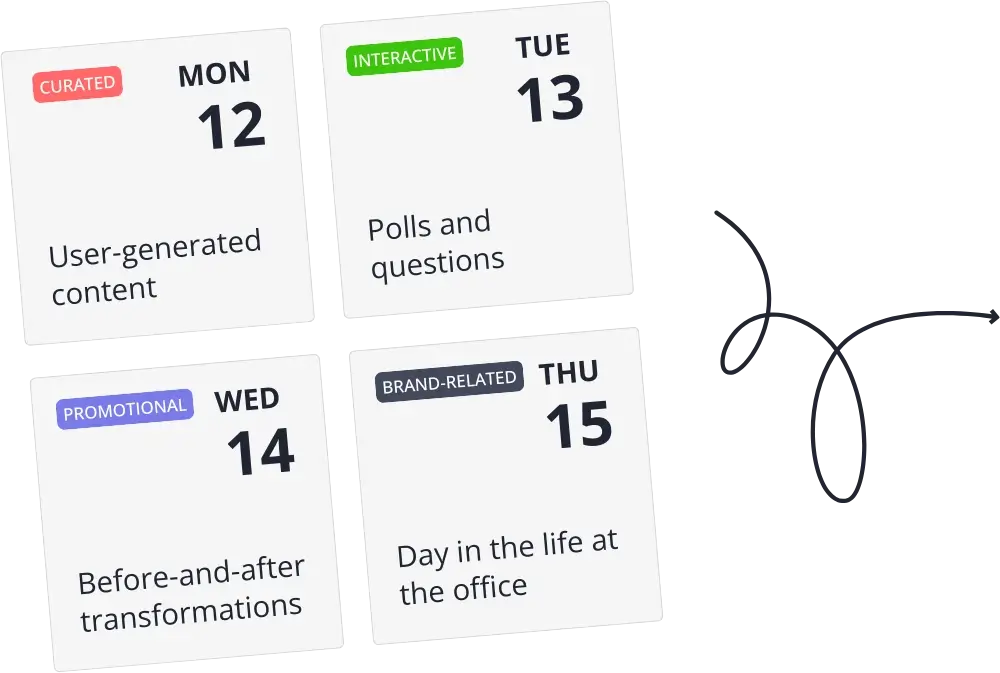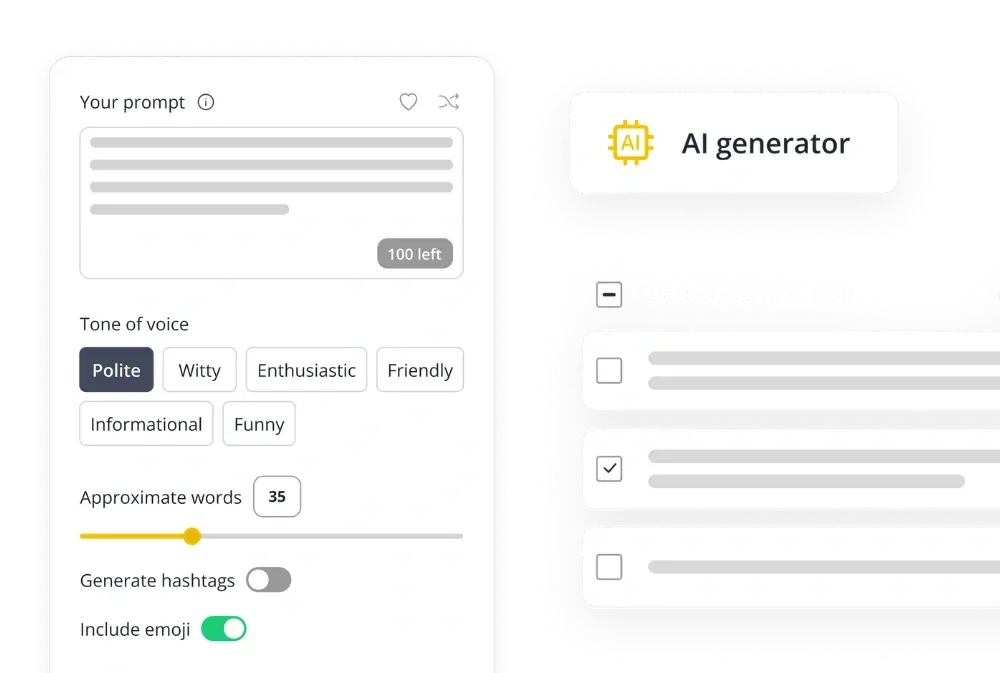
Content Writer at SocialBee
Facebook is still one of the biggest names in social media, shaping how we connect and how information gets shared.
Figuring out how Facebook’s algorithm works can feel tricky, whether you’re a user, marketer, or content creator. This guide breaks it down, giving you a clear and current look at what influences what shows up on your Feed.
If you want to grow your presence on Facebook or just understand what’s behind the posts you see, keep reading!
Short Summary
- The Facebook algorithm is a set of programming rules and machine learning techniques that determines the content displayed in a user’s Facebook Feed.
- It prioritizes posts, Stories, and ads based on factors like user interactions, content type, and the timeliness of posts, aiming to create a personalized and engaging experience for each user.
- The Facebook algorithm works through a four-step process: inventory, signals, predictions, and relevance.
- The Facebook Reels algorithm operates with a distinctive approach that focuses on user engagement, content originality and quality, utilization of trending elements, community guidelines compliance, personalized recommendations, and algorithmic learning and adaptation.
- The uniqueness of Facebook’s recommendation system means that no two users will see the same set of recommendations. Facebook’s objective with this system is to provide relevant and valuable recommendations tailored to each individual.
What Is the Facebook Algorithm?
The Facebook algorithm uses programming rules and machine learning to decide what you see in your Facebook Feed. It selects posts, Stories, and ads based on your interactions, the type of content, and how recent the posts are, aiming to give you a personalized and engaging experience.
How the Facebook Algorithm Works in 2025
Facebook’s objective is to ensure users encounter posts that resonate with their interests and values. This includes posts from individuals and Facebook Groups they are connected with, as well as posts from new sources that are deemed relevant.
There are two types of content that the Facebook algorithm brings to users’ feeds:
- Connected content: This includes posts from friends, Facebook Groups, and liked pages.
- Recommended content: These are posts that are likely to interest the user, coming from pages or people they do not follow.
NOTE: There is also a third type of content, namely Facebook ads, but they are governed by targeted marketing strategies rather than the platform’s core algorithm.
1. How Does the Facebook News Feed Algorithm Work in 2025?
As of 2025, the Facebook algorithm has transformed into a sophisticated, AI-driven system focused on delivering content that resonates with users’ preferences.
While Meta acknowledges the algorithm’s imperfections and the possibility that it may never achieve flawlessness, there’s a clear commitment to evolving and refining its approach to align with user desires.
Amidst its intricate nature and the integration of advanced technologies such as AI and machine learning, the Facebook Newsfeed algorithm can be distilled into four primary ranking factors.
Here are the four ranking factors that Facebook uses for content evaluation:
- Inventory
- Signals
- Predictions
- Relevance
A. Inventory
Initially, the algorithm conducts an inventory of potential feed content. This includes posts shared by friends, Facebook pages followed by the user, and groups they are part of. Importantly, any content that breaches Facebook’s Community Standards is immediately excluded from consideration.
B. Signals
Next, the algorithm evaluates various ‘signals’ or ranking factors to gauge how relevant each piece of content is to the user.
These signals are numerous and diverse, such as the timing of the post, the identity of the poster, the user’s level of interaction with the poster, content type (e.g. links, photos, or videos), user engagement with similar posts, the user’s local time, and even the speed of their internet connection.
C. Predictions
Using these signals, the algorithm makes personalized predictions about the content’s relevance and value to the user. For instance, if a user interacts more with branded posts during early mornings, the algorithm will adjust to show more of those posts during that timeframe.
D. Relevance
Finally, each piece of content is assigned a ‘relevance score.’ Content with higher scores gets priority in the Feed.
After organizing the connected content, the algorithm begins to incorporate recommended content into the user’s Feed. To avoid monotony, it avoids showing consecutive posts from the same creator or a series of similar content types back-to-back.
2. How Does the Facebook Reels Algorithm Work in 2025?
In 2025, the Facebook Reels algorithm operates with a distinctive approach, tailored to the platform’s increasing emphasis on short-form video content. Understanding this Facebook algorithm change is key for creators and marketers looking to maximize their engagement and visibility through Reels.
Here are the factors the Facebook Reels algorithm takes into consideration:
- User engagement priority: The algorithm heavily prioritizes user engagement metrics like watch time, likes, comments, and shares. A critical aspect is the completion rate of each Reel — videos watched from start to finish are likely to be favored by the algorithm.
- Content originality and quality: Facebook limits the reach of content that lacks originality, restricting its distribution.
- Utilization of trending elements: Content that leverages trending audio, effects, and topics on Reels tends to reach more users.
- Community guidelines compliance: Videos that violate Facebook’s Community Guidelines are less likely to be promoted and can even be removed.
- Personalized recommendations: The algorithm considers users’ past behavior to suggest Reels that align with their interests and preferences.
- Algorithmic learning and adaptation: The Reels algorithm continuously learns and adapts based on user behavior and feedback. This means that the kind of content that gains traction can evolve, reflecting changes in user preferences and broader platform trends.
How Does Facebook Recommend Content?
Facebook’s system for recommending content presents a valuable opportunity for brands and creators to engage new audiences without relying on paid advertising.
The uniqueness of this recommendation system means that no two users will see the same set of recommendations, which aligns with Facebook’s objective to provide relevant and valuable recommendations tailored to each individual.
To enhance your content’s likelihood of being recommended, it’s crucial to understand and comply with Facebook’s guidelines. All content must meet Facebook’s Community Standards, a comprehensive set of rules outlined in their Transparency Center.
Examples of content that contravenes these standards and will be removed include violence, crime, suicide or self-injury, child exploitation or nudity, bullying or harassment, spam, inauthentic behavior, and misinformation.
However, adhering to these standards alone doesn’t guarantee recommendation eligibility. Facebook’s Recommendations Guidelines aim to uphold a higher standard than the Community Standards. Thus, not all content permissible on the platform is suitable for recommendations.
If you want to be recommended to Facebook users, avoid these five types of content:
- Content compromising safety, like discussions of self-harm, suicide, eating disorders, sexually explicit material, or promotion of regulated products
- Sensitive or low-quality content, such as ‘miracle’ health supplements or questionable financial schemes
- Disliked content by users, like clickbait or engagement bait
- Low-quality publishing, such as news content lacking transparent authorship
- False or misleading content, including fake news or claims debunked by independent fact-checkers, like vaccine misinformation.
Tips for Working with Facebook’s Algorithm
To optimize your Facebook marketing efforts and get the algorithm on your side, you need to have a strategic approach.
Here are some tips to help you optimize your content, engagement, and overall Facebook strategy:
- Create relevant content for your target audience
- Engage Facebook users and encourage interaction
- Experiment with different types of content
- Don’t use clickbait and engagement bait
- Avoid spreading fake news
- Post UGC and mention people in your posts
- Create engaging video content
- Don’t forget the basic status post
- Put ad dollars behind your most impactful content
1. Create Relevant Content for Your Target Audience
In the realm of social media marketing, your primary objective should always be to produce high-quality content that truly resonates with your audience.
The more relevant and effective your content is, the more likely it is to garner engagement, signaling to the platform’s algorithm that users are interested in seeing more of your posts.
Bear in mind that creating content that connects with your target audience doesn’t come with a universal formula, as every audience has its unique preferences. However, using metrics can be incredibly insightful. If certain posts don’t perform as expected, delve into the reasons behind this by analyzing data available in Facebook Insights.
Post at the Right Time for Facebook’s Algorithm
Creating relevant content alone may not be enough to drive results. This is why it’s essential to post when your audience is most active.
Here are the best times to post on Facebook for each day of the week:
- Best time to post on Facebook on Mondays: at 9 AM and again at 3 PM to 4 PM
- Best time to post on Facebook on Tuesdays: at 9 AM and 1 PM
- Best time to post on Facebook on Wednesdays: from 9 AM to 10 AM and in the early afternoons around 1 PM to 4 PM
- Best time to post on Facebook on Thursdays: at 10 AM and between 1 PM and 3 PM
- Best time to post on Facebook on Fridays: at 9 AM and between 1 PM and 3 PM
- Best time to post on Facebook on Saturdays: between 12 PM and 1 PM
- Best time to post on Facebook on Sundays: between 12 PM and 1 PM
Rather than attempting to manually upload your posts during peak posting hours, using a tool like SocialBee to simplify the management of your social media content can be incredibly beneficial.
Equipped with a powerful calendar feature, it enables you to schedule content at optimal times, ensuring that your posts get the attention they deserve.
Try SocialBee to schedule your Facebook posts at optimal times and stay on the good side of Facebook’s algorithm.
Start your 14-day free trial today!
Moreover, with SocialBee’s analytics, you can get accurate insights into the types of content that truly resonate with your audience.
This data-driven approach removes any uncertainty from the content creation process, enabling a more focused and effective approach to your Facebook strategy.

Master Facebook’s Algorithm with SocialBee’s Scheduling!
2. Don’t Use Clickbait and Engagement Bait
Facebook frequently updates its algorithm to identify and reduce the reach of posts that qualify as clickbait or contain spammy links.
Clickbait typically consists of exaggerated, almost spam-like content. It often makes over-the-top promises but fails to fulfill them, as seen in headlines like ‘The one acne treatment that works.’
Engagement bait, a different but related issue, involves using captions or images that explicitly prompt user actions, such as ‘Like this post if you are an early bird, share it if you’re a night owl.’
These tactics don’t genuinely enhance user interaction or provide value, which explains why they’re sanctioned by Facebook. To avoid this, create content that motivates users to engage without explicit prompts.
3. Engage Facebook Users and Encourage Interaction
In 2018, Facebook announced the prioritization of ‘meaningful interactions’ between users. Since interaction plays a significant role in how the Facebook algorithm ranks content, it’s crucial to design your posts with the intent of maximizing engagement.
The goal is to create content that compels users to pause their scrolling, interact with your post, and feel motivated to share it. Regardless of the content type you rely on, it should be crafted to spark dialogue.
PRO TIP: Effective conversation is a two-way street. Not only should your content inspire your audience to engage, but you should also make an effort to respond to them when possible.
To maximize your efforts, try SocialBee’s Engagement Module, a comprehensive solution for effective audience engagement.
Use SocialBee’s Social Inbox for a cohesive approach to social media.
Start your 14-day free SocialBee trial today!
SocialBee turns the complexity of community management into a cohesive experience through well-organized boards, streams, and notifications.
4. Avoid Spreading Fake News
Facebook has been actively combating the prevalence of fake news on the platform, intensifying efforts to identify signals that suggest misinformation or deceptive content.
Distributing fake news, regardless of the intent — whether to create a sense of urgency, instill fear, or for any other reason — is a violation of Facebook’s Community Standards. Repeatedly engaging in such practices can lead to severe consequences, including the risk of being banned from the platform.
5. Experiment with Different Types of Content
Diversifying your content types is key to discovering what resonates best with your Facebook audience. This includes experimenting with photos, text-based posts, GIFs, Reels, videos, and live videos. Each content type offers a unique way to engage your audience and can yield different results.
If you ever find yourself in a creative rut, SocialBee’s AI Post Generator can turn things around. Equipped with over 1000 AI prompts, the generator creates content that is tailored to your particular needs.
Use SocialBee’s AI prompt collection to experiment with new ideas each time you post on Facebook.
Start your 14-day free SocialBee trial today!
Moreover, you can use it to generate unique images from textual prompts, giving you the freedom to experiment with different visual concepts and ideas.
6. Post UGC and Mention People in Your Posts
Whenever you’re tagged in posts by others, use the opportunity to showcase user-generated content (UGC) on your page. Of course, always ensure you have the original poster’s consent before sharing their content.
PRO TIP: Transform your best reviews into concise Facebook posts. When you tag the individuals who left the reviews, it not only enhances engagement on the post but can also bring in new followers — especially if the reviewers weren’t already following you.
7. Create Engaging Video Content
Nowadays, Facebook offers a variety of video formats including Reels and Stories for shorter clips, as well as Facebook Videos on Demand and Live videos. Notably, Reels has emerged as Facebook’s most rapidly growing content format.
For your content to stand out, focus on crafting original and authentic videos that embody your brand’s unique voice.
To maintain viewer engagement, especially for mobile users, optimize your creative elements. This includes adhering to the recommended vertical video format, as well as incorporating shorter, more impactful text, clear and readable overlays, and concise headlines.
8. Don’t Forget the Basic Status Post
When trying to enhance your presence on the platform, it’s easy to get caught up in trying to outsmart the algorithm with complex strategies. However, don’t overlook the effectiveness of a simple status post — those without photos, videos, or links.
This isn’t to suggest that your Facebook Page should consist solely of status posts, but rather to highlight their value. They can be an excellent tool for conveying straightforward information and securing high engagement levels.
9. Put Ad Dollars Behind Your Most Impactful Content
The updated Facebook algorithm favors content that gains traction organically. By identifying posts that already perform well without paid promotion, you can amplify their reach effectively through boosted or sponsored content.
This approach often results in lower cost-per-click (CPC) rates due to the initial organic engagement, creating a cumulative, snowball effect when combined with advertising spend.
On the flip side, it’s best to avoid allocating advertising budgets to content that hasn’t performed well organically. Investing in these underperforming posts can lead to increased expenses with minimal impact, reducing the overall effectiveness of your advertising efforts.
Frequently Asked Questions
To reset your Facebook algorithm, clear your history and preferences. Navigate to your Facebook settings and find the ‘Your Facebook Information’ section. Here, you can clear your search history and click on ‘Off-Facebook Activity’ to manage or clear data that Facebook collects from other apps and websites.
To ‘re-train’ the Facebook algorithm, actively engage with the content you prefer (like, share, comment) and unfollow or hide posts from sources you’re less interested in.
This will signal to Facebook the type of content you want to see more of, effectively ‘resetting’ your algorithm to align with your current interests.
There could be several reasons why your Facebook posts aren’t reaching a wide audience.
Firstly, it could be due to the platform’s algorithm, which prioritizes content that generates engagement. If your posts aren’t getting likes, comments, or shares, they might not be widely distributed.
Secondly, your posting times might not align with when your audience is most active. Experiment with posting at different times to see when you get the most engagement.
Lastly, ensure your content is engaging and relevant to your audience. High-quality, interesting posts are more likely to be shared and seen by a larger audience.
‘Beating’ the Facebook algorithm involves understanding and aligning your content strategy with how the platform prioritizes content:
- Post engaging, high-quality content that encourages interaction
- Use engaging captions, ask questions, or create polls to encourage comments
- Post consistently, but focus on quality over quantity
- Utilize Facebook’s features like Stories, Live videos, or Groups to increase engagement
- Engage with other posts and respond promptly to comments
- Understand your audience’s preferences and behaviors, using analytics to align your social media strategy with what resonates with your audience.
Make the Facebook Algorithm Work for You!
To wrap up, understanding the Facebook algorithm is crucial for anyone looking to maximize their presence on the platform. From prioritizing genuine engagement to creating high-quality, resonant content, the strategies we’ve discussed are key to ensuring your posts get the visibility and interaction they deserve.
As you venture into applying these insights to your Facebook strategy, leveraging tools like SocialBee for a streamlined approach to managing your social media content is essential.
Start your 14-day free SocialBee trial and elevate your social media game in 2025!

